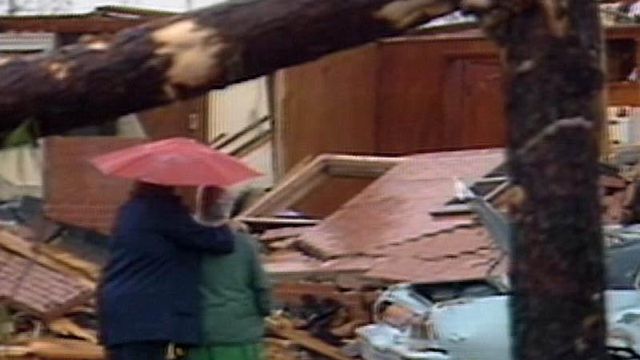Tornado outbreak changed lives, forecasting
Twenty-two tornadoes raked North and South Carolina during a six-hour period on March 28, 1984, killing 57 people, injuring more than 1,200 and causing an estimated $578 million in damage.
Posted — UpdatedHayes, now a teacher at West Clayton Elementary School, was a freshman at Red Springs High School in March 1984 and had had an argument with her father over algebra.
"I was laying down, just being angry," she said. "There was a bad storm, and I remember hearing hail. I remember it getting just deathly silent, and then the next thing I knew, I was trying to climb out of my house."
The tornado that hit Red Springs was among 22 twisters that raked North and South Carolina during a six-hour period on March 28, 1984, killing 57 people, injuring more than 1,200 and causing an estimated $578 million in damage.
Forty-two of the fatalities occurred in North Carolina, where the system was the largest tornado outbreak in more than a century. A path of destruction that was almost two miles wide in some places stretched from Robeson County on the South Carolina line to Gates County on the Virginia line.
WRAL Chief Meteorologist Greg Fishel covered the storms from Raleigh.
"When I came in the morning before, I looked at the forecast patterns in the upper atmosphere and I figured, 'Oh my gosh, I've seen that a lot in the Midwest but never along the East Coast,'" Fishel said.
{{/a}}
The jet stream over the state caught his eye, and as he studied the maps, isobars and surface conditions, his gut began to churn.
"The range of emotions I felt that day I will never forget," Fishel said, recalling his worry that his forecasts had been overblown because WRAL hadn't received any damage reports that night.
"The tornadoes had knocked out a lot of the communications," he said. "I went from fearing I had blown it out of proportion to thinking I hadn't done enough."
The tornadoes yanked up giant trees and trampled them like weeds, blasted proudly built homes into scrap heaps and tossed pickup trucks about like toys.
"It was really black. You couldn't tell anything until the lightning would flash. Then, you could see things right around you," Red Springs resident Billy Baxley said.
Baxley and his little sister, 2-year-old Tanya Michelle Baxley, had gone to Red Springs United Pentecostal Church on the outskirts of town for a Wednesday night Bible study session.
"She was the kind of baby that would just love to come to church," church pastor Rev. Waymon Oxendine said of Tanya, noting she would often wander among the pews, giggling.
The tornado blew the church apart, killing Tanya.
"The walls came caving in, and the top of the building came down," said Oxendine, whose ribs were broken when the collapsed roof pinned him to the floor.
Hayes' house also collapsed when the twister hit it.
"I remember I was screaming for my parents, my dad especially," she said.
By the time her father pulled her out, he had about 50 nail holes gouged into his feet, including more than a dozen places where the nails had gone straight through his feet. Traci Hayes' back was broken in the storm, but she and her father walked three blocks for help.
"We couldn't drive. The driveway was blocked, and one of the cars was smashed in," she said.
Mayor George Paris, who has led Red Springs for 30 years, said the town looked like a bomb had hit it.
"It's hard to explain. It looked like a war zone," Paris said. "I tell you what (the storm) did do. It made us a stronger community because people had to pull together."
For example, the tornado left a treasured centerpiece of the town, Red Springs Presbyterian Church, in tatters. Bricks were knocked away, and the bell tower was sheared off.
"I saw the Bible was still there on the lectern. It hadn't moved, and it was open to Jeremiah," said Dr. Charles Johnson, a church member who walked amid the ruins that night.
Since then, the pews, the stained glass and the bell tower have all been replaced or rebuilt. Johnson said the church looks exactly as it did before the tornado.
Unlike the church, severe-weather forecasting has changed tremendously in the past 25 years. Doppler radar, computer models and instant communications with the Internet make predicting and warning the public about events like the tornado outbreak easier.
A 1984 congressional hearing in Rocky Mount about the tornado outbreak helped jump-start federal funding for more and better forecasting tools and for a network of weather spotters. Fishel testified at the hearing, and he said improved technology has made severe-weather forecasting more precise.
"We are starting to warn smarter, educating schools and business of the specific path of the storm. Not everyone may need to take shelter, but some schools and businesses need to shelter and to get to it quickly," he said.
Still, people in Red Springs look back at the March 1984 tornado and wonder if Tanya Baxley could have been saved.
"Things that could have happened, (God) prevented from happening by taking her that night," Oxendine said. "That's what God is – he's a loving God."
• Credits
Copyright 2024 by Capitol Broadcasting Company. All rights reserved. This material may not be published, broadcast, rewritten or redistributed.






